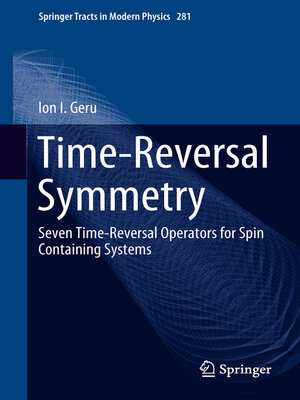Time-Reversal Symmetry
ebook ∣ Seven Time-Reversal Operators for Spin Containing Systems · Springer Tracts in Modern Physics
By Ion I. Geru

Sign up to save your library
With an OverDrive account, you can save your favorite libraries for at-a-glance information about availability. Find out more about OverDrive accounts.
Find this title in Libby, the library reading app by OverDrive.



Search for a digital library with this title
Title found at these libraries:
| Library Name | Distance |
|---|---|
| Loading... |
This book introduces new developments in the field of Time-Reversal Symmetry presenting, for the first time, the Wigner time-reversal operator in the form of a product of two- or three time-reversal operators of lower symmetry. The action of these operators leads to the sign change of only one or two angular momentum components, not of all of them. It demonstrates that there are six modes of time-reversal symmetry breaking that do not lead to the complete disappearance of the symmetry but to its lowering. The full restoration of the time-reversal symmetry in the six cases mentioned is possible by introducing six types of metaparticles. The book also confirms the presence of six additional time-reversal operators using a group-theoretical method. The problem is only where to seek these metaparticles.
The book discusses time-reversal symmetry in classical mechanics, classical and relativistic electrodynamics, quantum mechanics and theory of quantized fields, including dynamical reversibility and statistical irreversibility of the time, Wigner's and Herring's criteria, Kramers theorem, selection rules due to time-reversal symmetry, Onsager's relations, Poincaré recurrence theorem, and CPT theorem. It particularly focuses attention on time-reversal symmetry violation. It is proposed a new method of testing the time-reversal symmetry, which is confirmed experimentally by EPR spectroscopy data.
It shows that the traditional black-white point groups of magnetic symmetry are not applicable to magnetic systems with Kramers degeneration of energy levels and that magnetic groups of four-color symmetry are adequate for them. Further, it addresses the predicted structural distortions in Kramers three-homonuclear magnetic clusters due to time-reversal symmetry that have been identified experimentally.
Lastly, it proposes a method of synthesis of two-nuclear coordination compounds with predictable magnetic properties, based on the application of the time-reversal transformation that was confirmed experimentally.







